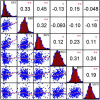A Genome-Wide Association Study Dissects the Genetic Architecture of the Metaxylem Vessel Number in Maize Brace Roots
- PMID: 35360304
- PMCID: PMC8961028
- DOI: 10.3389/fpls.2022.847234
A Genome-Wide Association Study Dissects the Genetic Architecture of the Metaxylem Vessel Number in Maize Brace Roots
Abstract
Metaxylem vessels in maize brace roots are key tissue, and their number (MVN) affects plant water and inorganic salt transportation and lodging resistance. Dissecting the genetic basis of MVN in maize brace roots can help guide the genetic improvement of maize drought resistance and lodging resistance during late developmental stages. In this study, we used 508 inbred lines with tropical, subtropical, and temperate backgrounds to analyze the genetic architecture of MVN in maize brace roots. The phenotypic variation in MVN in brace roots was evaluated in three environments, which revealed broad natural variation and relative low levels of heritability (h 2 = 0.42). Stiff-stalk lines with a temperate background tended to have higher MVNs than plants in other genetic backgrounds. MVN was significantly positively correlated with plant height, tassel maximum axis length, ear length, and kernel number per row, which indicates that MVN may affect plant morphological development and yield. In addition, MVN was extremely significantly negatively correlated with brace root radius, but significantly positively correlated with brace root angle (BRA), diameter, and number, thus suggesting that the morphological function of some brace root traits may be essentially determined by MVN. Association analysis of MVN in brace roots combined 1,253,814 single nucleotide polymorphisms (SNPs) using FarmCPU revealed a total of nine SNPs significantly associated with MVN at P < 7.96 × 10-7. Five candidate genes for MVN that may participate in secondary wall formation (GRMZM2G168365, GRMZM2G470499, and GRMZM2G028982) and regulate flowering time (GRMZM2G381691 and GRMZM2G449165). These results provide useful information for understanding the genetic basis of MVN in brace root development. Further functional studies of identified candidate genes should help elucidate the molecular pathways that regulate MVN in maize brace roots.
Keywords: GWAS; brace root; candidate gene; maize (Zea mays L.); metaxylem vessel number.
Copyright © 2022 Liu, Zhang, Yu, Li, Zhang, Cui, Dong, Fan, Zhang, Li and Ruan.
Conflict of interest statement
The authors declare that the research was conducted in the absence of any commercial or financial relationships that could be construed as a potential conflict of interest.
Figures







Similar articles
-
Genome-wide association study reveals the genetic basis of brace root angle and diameter in maize.Front Genet. 2022 Oct 6;13:963852. doi: 10.3389/fgene.2022.963852. eCollection 2022. Front Genet. 2022. PMID: 36276979 Free PMC article.
-
Genome-wide association study and genomic selection of brace root traits related to lodging resistance in maize.Sci Rep. 2024 Dec 30;14(1):31898. doi: 10.1038/s41598-024-83230-9. Sci Rep. 2024. PMID: 39738690 Free PMC article.
-
Maize brace roots provide stalk anchorage.Plant Direct. 2020 Nov 8;4(11):e00284. doi: 10.1002/pld3.284. eCollection 2020 Nov. Plant Direct. 2020. PMID: 33204937 Free PMC article.
-
Maize plants and the brace roots that support them.New Phytol. 2023 Jan;237(1):48-52. doi: 10.1111/nph.18489. Epub 2022 Sep 30. New Phytol. 2023. PMID: 36102037 Review.
-
Bracing for sustainable agriculture: the development and function of brace roots in members of Poaceae.Curr Opin Plant Biol. 2021 Feb;59:101985. doi: 10.1016/j.pbi.2020.101985. Epub 2021 Jan 5. Curr Opin Plant Biol. 2021. PMID: 33418403 Review.
Cited by
-
Genome-wide association study reveals the genetic basis of brace root angle and diameter in maize.Front Genet. 2022 Oct 6;13:963852. doi: 10.3389/fgene.2022.963852. eCollection 2022. Front Genet. 2022. PMID: 36276979 Free PMC article.
-
Plant microphenotype: from innovative imaging to computational analysis.Plant Biotechnol J. 2024 Apr;22(4):802-818. doi: 10.1111/pbi.14244. Epub 2024 Jan 13. Plant Biotechnol J. 2024. PMID: 38217351 Free PMC article. Review.
-
Genome-wide association study presents insights into the genetic architecture of drought tolerance in maize seedlings under field water-deficit conditions.Front Plant Sci. 2023 May 8;14:1165582. doi: 10.3389/fpls.2023.1165582. eCollection 2023. Front Plant Sci. 2023. PMID: 37223800 Free PMC article.
-
Advancements and Prospects of Genome-Wide Association Studies (GWAS) in Maize.Int J Mol Sci. 2024 Feb 5;25(3):1918. doi: 10.3390/ijms25031918. Int J Mol Sci. 2024. PMID: 38339196 Free PMC article. Review.
-
Utilizing Two Populations Derived from Tropical Maize for Genome-Wide Association Analysis of Banded Leaf and Sheath Blight Resistance.Plants (Basel). 2024 Feb 4;13(3):456. doi: 10.3390/plants13030456. Plants (Basel). 2024. PMID: 38337988 Free PMC article.
References
-
- Alvarado G., Rodríguez F. M., Pacheco A., Burgueño J., Crossa J., Vargas M., et al. (2020). META-R: a software to analyze data from multi-environment plant breeding trials. Crop J. 5 745–756. 10.1016/j.cj.2020.03.010 - DOI
LinkOut - more resources
Full Text Sources

